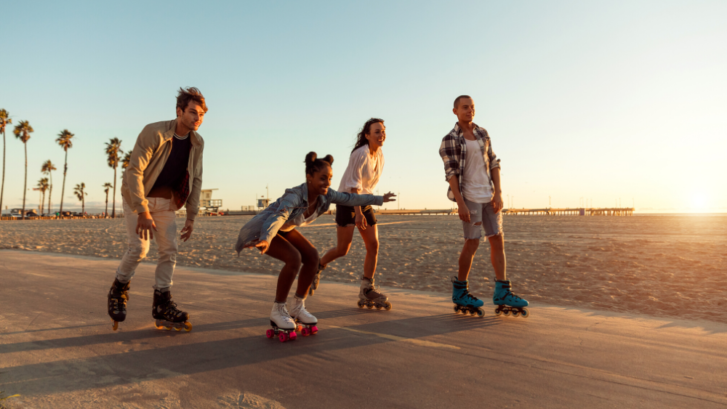Roller Skating 101: Avoid Common Injuries and Fall Safely
Though roller skates have existed since the 1700s, roller skating first became a more popularized hobby in America in early 1960’s and 70’s. It is a pillar of dance, sport, artistic expression, culture, and more, and once again has become more popularized as a solo-sport since the start of the COVID-19 pandemic.
Whether you’ve started skating with intentions to someday join a derby league, or maybe because you just wanna have fun or dance with somebody at the roller rink, Healthpointe has a few basic tips that you should know when first learning how to roller skate, so that you can maximize your safety, and double your fun.
Common Injuries and Protective Gear
Some of the most common skate injuries include wrist fractures and sprains – both new skaters and pros are prone to falling, and while there are “safe” ways to fall, sometimes accidents do happen. One way to help protect your wrists from potential injuries is by investing in wrist guards. They’re relatively inexpensive, and will ensure that your wrists remain in proper form and positioning, so that if you do fall, you’ll be less likely to sustain a fracture or sprain.
Like many other high-intensive wheeled sports, concussions are also a risk to those in the skating community. Although many comfortable and experienced skaters will tend to use helmets less-often than others, new outdoor skaters should consider finding an appropriate helmet before attempting to street skate or before learning any cool skate moves. To learn more about avoiding concussions, read our article, Tips to Prevent Concussions, and if you suspect that you’ve sustained a concussion, be sure to seek immediate medical care.
Elbow and knee guards are also important for protecting your extremities from scrapes and cuts, bruising, and road rash, and skate gloves can protect your hands if and when you need to catch yourself from falling. Mouth-guards may also be a worthy investment if you’re more serious about outdoor skating, or joining a roller derby league or roller hockey team.
How to Fall Safely
Just because you have protective gear, doesn’t mean that you’ll automatically become safe from falling – joint separations, broken bones, and head injuries are just a few of the things that can happen if you fall incorrectly while on skates. Deborah Harry, from Dirty School of Skate, suggests “collapsing down, and surrendering to the fall,” rather than allowing your arms to flail and your feet to come out forward from underneath you.
One of the easiest ways to surrender into a fall is to squat down low if you feel yourself destabilizing. This will do one of two things: allow you to re-center yourself and find your balance again without falling, or allow you to fall at a closer distance from the floor, which will minimize the strength of the initial impact from falling.
If squatting down low doesn’t help you regain your balance, you can then surrender into the fall from a squatting position, in one of two ways. If you’re at a skate rink and surrounded by lots of people, it might not be safest to fall onto outstretched arms and hands, as this may put your hands at risk for being rolled over by other skaters. In this case, you might choose to land on your bottom, in a sitting-down position, with hands planted on the floor to your sides, and fingers safely tucked away.
In an environment where there are less people around, it may be safer for you to catch yourself with your hands. You should have your arms slightly bent for this, and should lean right or left into your fall, almost as if you’re going to begin doing push-ups. Becoming rigid will only make your fall more painful, so keeping your arms bent is crucial here.
Getting Up and Trying Again
Once you’ve fallen, your first instinct in getting back up may be to simply stand, but this won’t work when both of your feet are attached to wheels. To get back up quickly and easily, readjust yourself into a kneeling position, with both feet out behind you. Then, plant one foot (whichever you’re most comfortable with) out in front of you, almost as if you’re about to propose. Next, use your arms to help you slowly push off both the ground and off your lifted and bent knee, and back into a standing position.
Staying active is important to all of us here at Healthpointe, whether you’re a skater, runner, basketball player, or all-around athletic enthusiast. We believe that your safety is paramount to you, your family, and your livelihood, and hope these tips help you feel confident and safe in any and all of your skating endeavors!
Have you taken a hard fall that has severely impacted your life, and need better help in getting back up into the daily swing of things again?
Healthpointe can help – with 11 multi-specialty medical clinics located across Southern California, we’re equipped to give you the highest quality healthcare including all of your sports medicine needs, so that you can stay active and healthy, and live your life to the fullest.
To learn more about Healthpointe’s Sports Medicine program, click here, and to make an appointment, visit https://healthpointe.net/ or call (888) 824-5580 today!



